“Natural” Doesn’t Mean Safe
With legalization of cannabis all the rage for humans right now, there’s are already derivatives that are being marketed for pet use. Tea tree oil, marijuana and other cannabis compounds are just a few of the “natural” products that can be toxic to pets. Part of the problem is that the alternative/homeopathic/holistic/herbal supplement industries for people and nonhuman animals are unregulated to any significant degree. Natural doesn’t mean safe and even nontoxic herbs have potential side effects. Pet owners should always discuss over the counter remedies with their primary care veterinarian before administering any natural or herbal compound for any reason. Dr. Google doesn’t know everything, Mother Nature can be nasty, and your veterinarian knows your pet’s needs best.
 Did you know that asymmetrical tail wagging (more to the left or right) means something? Dogs wagging their tails to the right are happy, but dogs wagging their tails to the left are anxious. Not only that, other dogs watching know the difference! A dog watching another dog wagging asymmetrically to the left (anxiety) will experience anxiety confirmed by measuring increased heart rate and anxious facial expression. Too bad we don’t have tails! Maybe we’d understand each other better…
Did you know that asymmetrical tail wagging (more to the left or right) means something? Dogs wagging their tails to the right are happy, but dogs wagging their tails to the left are anxious. Not only that, other dogs watching know the difference! A dog watching another dog wagging asymmetrically to the left (anxiety) will experience anxiety confirmed by measuring increased heart rate and anxious facial expression. Too bad we don’t have tails! Maybe we’d understand each other better…
The notion of ‘hypoallergenic dogs’, often associated with poodles and others, is a myth. According to a recent study by Dr. Christine Cole Johnson and colleagues, published by The American Journal of Rhinology and Allergy, there does not seem to be any significant difference in dog allergens associated with breeds that are supposedly “hypoallergenic” breeds.  Dogs who shed less than others do not necessarily have less dander (hair and skin that are normally shed by dogs); instead, this seems to be related to individual dogs rather than to the breed. It is possible that some breeds shed less dander, but the amount of dander apparently makes little difference to allergy sufferers.
Dogs who shed less than others do not necessarily have less dander (hair and skin that are normally shed by dogs); instead, this seems to be related to individual dogs rather than to the breed. It is possible that some breeds shed less dander, but the amount of dander apparently makes little difference to allergy sufferers.
As part of this study, dust samples from homes of 173 one-dog families were collected, and 163 of them produced levels of the major dog allergen, Canis familiaris 1, or Can f 1. Although sample size did not allow for analysis by individual breed, researchers compared quantities of allergens between groups of purebred and mixed-breed “hypoallergenic” and “non-hypoallergenic” dogs, and found no statistically significant differences in levels of Can f 1. This interesting study is not conclusive at this point, but it does imply that the individual dog, not breed, and the individual person with allergies, are the most important variables.
 According to VPI, the Veterinary Pet Insurance Company, the most popular dog names in 2010 in descending order of popularity were Bella, Bailey, Max, Lucy, Molly, Buddy, Maggie, Daisy, Charlie and Sophie. For cats, they report Max, Bella, Chloe, Oliver, Lucy, Smokey, Shadow, Tiger, Tigger and Charlie.
According to VPI, the Veterinary Pet Insurance Company, the most popular dog names in 2010 in descending order of popularity were Bella, Bailey, Max, Lucy, Molly, Buddy, Maggie, Daisy, Charlie and Sophie. For cats, they report Max, Bella, Chloe, Oliver, Lucy, Smokey, Shadow, Tiger, Tigger and Charlie.
Smokey, a cat who lives in the UK, supposedly has the loudest purr “in the world”. Although her purring has not been compared to every cat in the world, her purr is quite loud. The average cat’s purr is about 25 decibels. Measured up close, Smokey purrs at an impressive 80-92 decibels, which rivals the sound of a lawnmower, hair dryer or Boeing 737 coming in for a landing. Perhaps you’d care to take up the challenge and measure your cat’s purr!
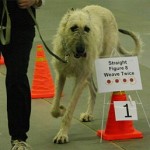
Dog rally station
AKC Rally is a great new dog handling sport. Moving at their own pace, each canine team must demonstrate basic obedience skills and communication between handler and dog. The rally course is designed by the judge and has between 10 to 20 stations; the dog is required to perform a moving or stationary skill at each station. To compete in rally events, dogs must be older than 6 months, spayed or neutered, and registered purebred dogs or listed with the alternative listings. For more information about AKC Rally, just visit http://www.akc.org/events/rally/
The American Veterinary Medical Association has recently launched a campaign to promote the restraint of dogs in your car. Called “Please Show Some Restraint”, the AVMA is reacting to a survey conducted by American Automobile Association. Results showed that as many as one third of dog owners admit they are distracted by their pets while driving, Distracted driving is a leading cause of car accidents, according to the National Highway Traffic Safety Administra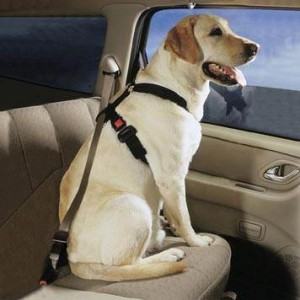 tion.
tion.
Pet harnesses for car travel typically attach to seat belts or car seat. Some models for smaller dogs have booster seats that anchor to the car seats. Other styles offer lines that attach to the interior of the car so dogs can move around. Car restraints can be found at most pet stores and online. Cats should travel in crates, and often feel more secure in a cozy carrier.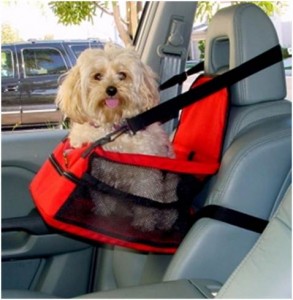
Of course, you can also secure the car seat belt and tie your dog to it (using a harness for car travel is preferred to prevent neck injury) on a short leash for control. Offer a rawhide chew or other chew toy to keep your dog busy. Most importantly, if you are going on a long ride, get your dog ready with a long walk or run before you set off on the road. Make frequent stops along the way to help break up the trip for both of you. And, of course, make sure your pets are microchipped just in case you are separated. Happy trails!
In April 2010, the US Food & Drug Administration warned pet owners that they should not give bones, poultry or any other bone, to their pets. Here are the top 10 reasons bones should be off limits to pets:
- Chewing on bones can result in broken teeth that require expensive treatment.
- Bones can cause traumatic injury to the mouth or tongue.
- A bone can loop around your dog’s lower jaw, causing a frightening and painful experience and costly emergency treatment to remove it.
- Bone can get stuck in the esophagus (food travels through this tube to the stomach) and cause your dog to gag or vomit; this could lead to emergency surgery.
- If your dog accidentally inhales a small fragment of bone into the windpipe (trachea), emergency veterinary care will be necessary to save your dog’s life.
- A bone can get stuck in the stomach and your dog will require emergency surgery or other procedures under anesthetic to remove the bone, as well as treatment of any injury it has caused to the gastrointestinal tract.
- Bones gets stuck and cause intestinal blockage that will also require emergency veterinary care.
- Bone fragments cause constipation.
- Some fragments are so sharp that they traumatize the inside of the large intestine or rectum as they pass. This is painful and can cause serious rectal bleeding and require emergency treatment.
- If bone fragments tear the delicate lining of the stomach or intestines, a dangerous bacterial infection of the abdomen (peritonitis) can be fatal and will require hospitalization and intensive care.
![Bee_honeycomb[1]](http://petbehavior.org/wp-content/uploads/2010/11/Bee_honeycomb1-300x225.jpg) Scientists of the US military at Los Alamos National Laboratory in New Mexico have managed to train the common honey bee to detect chemical explosives used in bombs. It seems that bees have a fantastic sense of smell that rivals that of dogs. Using Pavlovian techniques on the bees’ natural response to nectar, a sticking out of their tongue, their skill might be applied to protect American troops and civilians alike (December 2005 online statement).
Scientists of the US military at Los Alamos National Laboratory in New Mexico have managed to train the common honey bee to detect chemical explosives used in bombs. It seems that bees have a fantastic sense of smell that rivals that of dogs. Using Pavlovian techniques on the bees’ natural response to nectar, a sticking out of their tongue, their skill might be applied to protect American troops and civilians alike (December 2005 online statement).
If you won’t quit smoking for yourself, do it for your PETS! It’s been proven for some time now that spouses and children of smokers have increased health problems from second-hand smoke. Now we also know it effects smokers’ pets. Cats who lived with a smoker had double the risk of malignant lymphoma. Cats with prolonged exposure to in-home smoking had a four-fold risk of contracting lymphoma. Most of the cats’ cancers were in the nasal or gastrointestinal tract, which fits inhalation as the source, or the possibility that cats swallow smoke particles lodged in their fur when they groom themselves. There’s no reason to think dogs would be any less impacted. [References: 1) Bertone ER, Snyder LA, Moore AS. Environmental tobacco smoke and risk of malignant lymphoma in pet cats. American Journal of Epidemiology. 2002;156:268-273. 2) Raloff J. Cigarette smoke can harm kitty, too. Science News. 2002;162:125.]
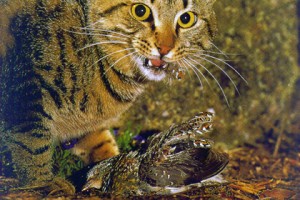 Feral and free-roaming cats pose a serious threat to endangered species nationwide. Cats are not native to North America and wildlife has never evolved to cope with the millions of cats around the country that prey upon them. In Florida alone, there are 15 million cats that roam. A recent study by the U. of Florida, commissioned by the U.S. Fish and Wildlife Service, stated that cats impact native wildlife in three primary ways: predation, competition, and diseases such as rabies. In Florida, endangered species that are seriously impacted by hunting cats include Key Largo cotton mouse, Key Largo woodrat, Lower Florida Keys marsh rabbit, Choctawhatchee beach mouse, Perdido Key beach mouse, green sea turtle, roseate tern, least tern and the Florida scrub jay. In California and Hawaii, the Hawaiian goose, California brown pelican and blunt nosed leopard lizard are in additional peril because of cats. All forms of life have a right to be here. We must protect those who cannot protect themselves. Think of what your outdoor cat is doing to the wildlife in your area. Please keep your cat indoors.
Feral and free-roaming cats pose a serious threat to endangered species nationwide. Cats are not native to North America and wildlife has never evolved to cope with the millions of cats around the country that prey upon them. In Florida alone, there are 15 million cats that roam. A recent study by the U. of Florida, commissioned by the U.S. Fish and Wildlife Service, stated that cats impact native wildlife in three primary ways: predation, competition, and diseases such as rabies. In Florida, endangered species that are seriously impacted by hunting cats include Key Largo cotton mouse, Key Largo woodrat, Lower Florida Keys marsh rabbit, Choctawhatchee beach mouse, Perdido Key beach mouse, green sea turtle, roseate tern, least tern and the Florida scrub jay. In California and Hawaii, the Hawaiian goose, California brown pelican and blunt nosed leopard lizard are in additional peril because of cats. All forms of life have a right to be here. We must protect those who cannot protect themselves. Think of what your outdoor cat is doing to the wildlife in your area. Please keep your cat indoors.
In January 2003, European leaders agreed to ban cosmetics testing on animals and the marketing of animal-tested cosmetic products in the European Union. Cosmetics companies will have until 2009 to develop alternatives for testing products such as shampoos, lotions, and deodorants, in addition to mascara and eye shadow! Apparently, US companies think this is merely an ’emotional issue’, however, for all the right reasons, I think the ban is long overdue.
 The American Veterinary Medical Association (AVMA) does NOT advise the transport of dogs, either loose or tethered, in the open cargo of pickup trucks. Dogs should either travel in the safety and company of their owners in the cabin, or in a secured, ventilated, and size-appropriate kennel.
The American Veterinary Medical Association (AVMA) does NOT advise the transport of dogs, either loose or tethered, in the open cargo of pickup trucks. Dogs should either travel in the safety and company of their owners in the cabin, or in a secured, ventilated, and size-appropriate kennel.
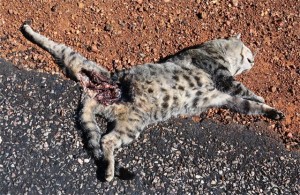 The AVMA is against letting pet cats go outside. Cat owners in urban and suburban areas are strongly encouraged to keep their pets confined indoors. The life expectancy of an outdoor cat is just 2 to 5 years compared to indoor pets who may live as long as 17 years or more. Outdoor cats are favorite prey for coyotes and other predators, and are exposed to deadly viruses and bacterial infections from contact with other cats and other animals. They may be captured and abused by disturbed people, or be hit by motor vehicles and die lonely, painful deaths. It isn’t cruel to keep your cat indoors, but it is cruel to let them outside.
The AVMA is against letting pet cats go outside. Cat owners in urban and suburban areas are strongly encouraged to keep their pets confined indoors. The life expectancy of an outdoor cat is just 2 to 5 years compared to indoor pets who may live as long as 17 years or more. Outdoor cats are favorite prey for coyotes and other predators, and are exposed to deadly viruses and bacterial infections from contact with other cats and other animals. They may be captured and abused by disturbed people, or be hit by motor vehicles and die lonely, painful deaths. It isn’t cruel to keep your cat indoors, but it is cruel to let them outside.
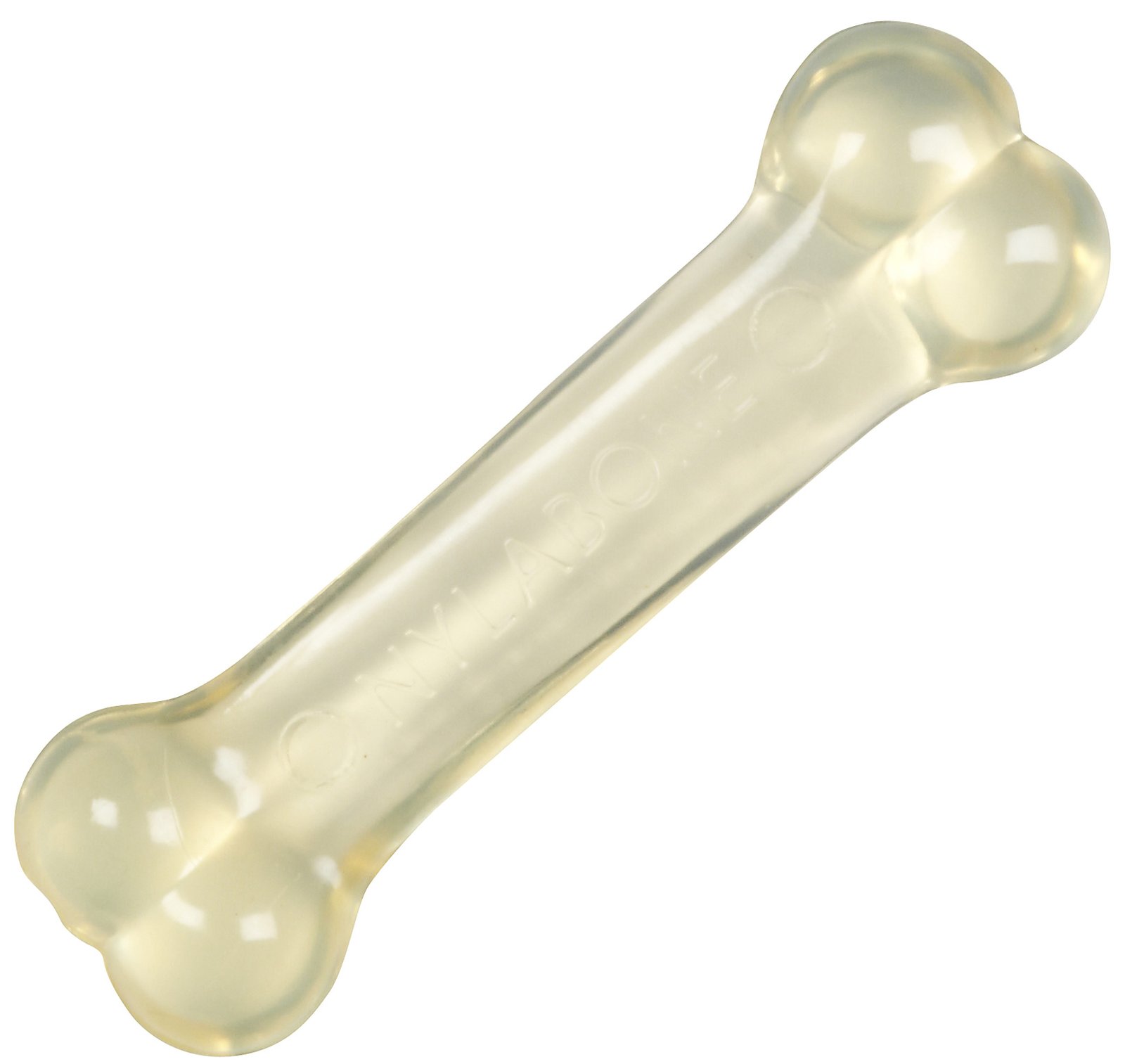 The Nylabone® company has pulled its Plaque AttackerTM (including Gumma-BoneTM) line of polymer plastic dog bones from the shelves. This was in response to an alarming number of cases, including several fatalities, in which dogs were reported to have swallowed chunks of broken bones. A class action suit is pending. Although bones made of polyurethane are recommended by many veterinarians as well as the ASPCA, Dr. Schwartz suggests that natural rawhide, in size and shape appropriate to your dog’s size and chewing style, should be preferred. At least they are biodegradable! Stay away from the big knotted bones if your doggy tends to bite off the ends. Rawhide strips, sticks, and rolled batons are generally safe under your supervision. Dr. Schwartz always says: “A busy mouth is a happy mouth”. Dogs have to chew. Give your dog a rawhide or risk finding him or her chewing on your remote control or computer cables! [Source: king5.com, Seattle News 11/22/01]
The Nylabone® company has pulled its Plaque AttackerTM (including Gumma-BoneTM) line of polymer plastic dog bones from the shelves. This was in response to an alarming number of cases, including several fatalities, in which dogs were reported to have swallowed chunks of broken bones. A class action suit is pending. Although bones made of polyurethane are recommended by many veterinarians as well as the ASPCA, Dr. Schwartz suggests that natural rawhide, in size and shape appropriate to your dog’s size and chewing style, should be preferred. At least they are biodegradable! Stay away from the big knotted bones if your doggy tends to bite off the ends. Rawhide strips, sticks, and rolled batons are generally safe under your supervision. Dr. Schwartz always says: “A busy mouth is a happy mouth”. Dogs have to chew. Give your dog a rawhide or risk finding him or her chewing on your remote control or computer cables! [Source: king5.com, Seattle News 11/22/01]
Did you know that dogs have a repertoire of 13 positions for passing urine? Some are more common in males or females, and the dog may take a position and remain stationery or keep on moving! Talk about talent!
